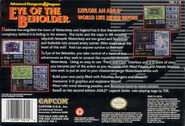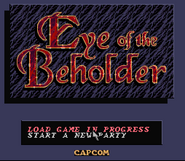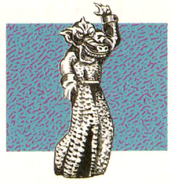However, if you can update it or further improve it, then please feel free to contribute.
Eye of the Beholder is a computer game released in 1991. It was developed by Westwood Associates and published by Strategic Simulations, Inc. for DOS, Amiga, Sega CD, SNES and PC-9800. It is the first game of the Eye of the Beholder series.
In Eye of the Beholder, you take control of a band of four adventurers as they seek to unravel the mysteries beneath Waterdeep. Using an easy to use "Point and Click" interface and 3-D point of view, you become part of the action as you do battle with Mind Flayers and Mantis Warriors who seek to put an end to your mission to purge Waterdeep of the evil.
- Awesome 3-D graphics and explosive sound!
- Filled with mind-blowing puzzles, and ferocious hand-to-hand combat.
Plot[]
The lords of the city of Waterdeep have grown concerned with mysterious happenings within the city. Luckily, Khelben "Blackstaff" Arunsun looks into lords' concerns — that an unknown evil poses a threat to Waterdeep. There are rumors of assassins wandering the streets, so the mage visits both Amn and Calimshan, as such places had given Waterdeep issues in the past. He, however, finds no evidence of devious plots outside of Waterdeep, and believes such evils must be coming from within. Arunsun's informants are clear on one thing — the word Xanathar recurs with great persistence.
The wizard uses his mages to detect evil, but cannot locate its exact source. After this, Khelben writes to Piergeiron the Paladinson, Open Lord of Waterdeep. He warns that the evil must come from inside Waterdeep, or more, under their very noses. Khelben returns to the council and tells Piergeiron to hire adventurers to look where they haven't — under the city. The council holds a ceremony, and write up an official document known as the commission and letter of Marque, and sends the adventurers away to prepare.
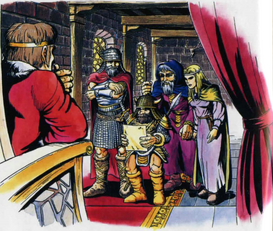
The Heroes of Waterdeep accept the commission and letter of Marque.
Two days before the adventuring group are due to search underground, the captain of the guard intercepts a drow scout that is spying on the council. Under interrogation, the drow reveals the disturbing plan of an evil beholder (who had recently teleported the elf to the surface). The spy reveals that the beholder crime lord, Xanathar, inhabits the lowest parts of the Waterdeep sewer system. The guards confiscate the drow's package of information, and Khelben sends it to the adventuring group.
With the official document, basic adventuring gear and a package of information, the adventurers enter the city's sewer system. As they descend, the entrance gets blocked by a sudden collapse, all planned by Xanathar. The team descends further beneath the city, going through dwarf and drow territory, to Xanathar's lair, where the final confrontation takes place. The party slay the evil beholder and present his eye stalk to the Lords of Waterdeep. The lords rejoice, and confer on the party the honorary name: the Heroes of Waterdeep.
Gameplay[]
Eye of the Beholder featured a first-person perspective in a three-dimensional dungeon, very similar to the earlier Dungeon Master. The player controls four characters, initially, using a point-and-click interface to fight monsters. This can be increased to a maximum of six characters, by resurrecting one or more skeletons from dead non-player characters (NPC), or finding NPCs that are found throughout the dungeons. The possibility to increase the size of the player's party through the recruiting of NPCs was a tradition in all of the Eye of the Beholder series. It was also possible to import a party from Eye of the Beholder into Eye of the Beholder II: The Legend of Darkmoon or from Eye of the Beholder III: Assault on Myth Drannor; thus, a player could play through all three games with the same party.
Index[]
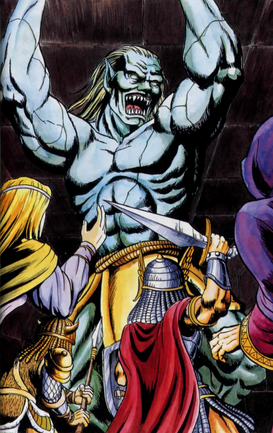
The Heroes of Waterdeep fend off a foe.
Characters[]
Referenced only
Bennet • Miltinda • Oltec • Wently Kelso
Creatures[]
Referenced only
rat
Locations[]
Magic[]
Miscellaneous[]
Gallery[]
Appendix[]
Japanese Version[]
- A Japanese version of Eye of the Beholder (アイ・オブ・ザ・ビホルダー) was released for Super Famicon. Whilst similar to the Eye of the Beholder games in the West, the Japanese version had some differences. For instance, the mind flayer enemies had trunks and snouts instead of tentacles. Also, the physical manuals and cluebooks contained artwork of the Heroes of Waterdeep, who are illustrated in greater detail than the original games.
Game Credits[]
- Amiga
- Director of product development (Westwood): Brett W. Sperry
- Game design (Westwood): Phillip W. Gorrow, Eydie Laramore, Paul S. Mudra, Joseph Bostic
- Original programming (Westwood): Phillip W. Gorrow
- Amiga programming (Westwood): Bill Stokes
- Graphics (Westwood): Rick Parks, Aaron E. Powell, Joseph B. Hewitt IV
- Music & sound effects (Westwood): Paul S. Mudra
- Writer (Westwood): Eydie Laramore
- Playtesting (Westwood): Glenn Sperry
- Rulebook writers (Westwood): Marc Cram, Michael Legg, Eydie Laramore
- Game development (SSI): George MacDonald
- Development support (SSI): David A. Lucca, Rick E. White
- Manual (SSI): Richard Wilson
- Playtesting (SSI): Michael H. Gilmartin, Cyrus G. Harris, John Kirk, Alan Marenco, Jeffrey Shotwell, Larry Stephen Webber, * James Young, John C. Boockholdt
- Special IBM Testing (SSI): Top Star Computer Services Inc.
- Additional Amiga Playtesting (SSI): Michael Silen, Mark Hall (Mark R. Hall)
- Art, graphic design & DTP (SSI): Peter Gascoyne (Louis Saekow Design)
- Pre‑press production (SSI): Kirk Nichols (Louis Saekow Design), Ray Garcia (Louis Saekow Design)
- Printing (SSI): American Lithographers
- Rulebook writers (SSI): George MacDonald, Richard Wilson
- Rulebook support by (SSI): Glen A. Cureton, John Kirk
- DOS
- Director of Product Development (Westwood): Brett W. Sperry
- Game Design (Westwood): Joseph Bostic, Phillip W. Gorrow, Eydie Laramore, Paul S. Mudra
- Original Programming (Westwood): Phillip W. Gorrow
- Amiga Programming (Westwood): Bill Stokes
- Graphics (Westwood): Aaron E. Powell, Joseph B. Hewitt IV, Rick Parks
- Music (Westwood): Paul S. Mudra
- Sound Effects (Westwood): Paul S. Mudra
- Writer (Westwood): Eydie Laramore
- Playtesting (Westwood): Glenn Sperry
- Game Development (SSI): George MacDonald
- Development Support (SSI): David A. Lucca, Rick E. White
- Manual (SSI): Richard Wilson
- Playtesting (SSI): John C. Boockholdt, Michael H. Gilmartin, Cyrus G. Harris, John Kirk, Alan Marenco, Jeffrey Shotwell, Larry Stephen Webber, James Young
- Special IBM Testing: Top Star Computer Services Inc.
- Art, Graphic Design & DTP (SSI): Louis Saekow Design, Peter Gascoyne
- Pre‑press Production (SSI): Louis Saekow Design, Ray Garcia, Kirk Nichols
- Printing: American Lithographers Inc.
- Cover artwork: Jeff Easley
- PC-9800
- Project Leader: Yasutaka Ukai
- Chief Programmer: Makoto Ichinoseki
- Sub Programmer: Hiroyuki Fujiwara, Hidefumi Ohara
- Graphic Design: Atsuhiro Gunji, Rieko Yoshida
- Music: Yuzo Koshiro, Yuji Yamada
- Translation & Supervision: Hitoshi Yasuda, Miyuki Kiyomatsu, Megumi Tsuge
- Promotion: Yoshiaki Matsumoto, Nobuaki Suzuki
- Debug: Masaaki Furuya, Kiyoto Yoshimura
- SEGA CD
- Producer: Yasutaka Ukai, Makoto Ichinoseki
- Technical Support: Hiroyuki Fujiwara, Satoru Miki
- Graphics: Atsuhiro Gunji, Hiroshi Akagi, Ken Takagi, Yasuaki Mizutani, Saeko Satou, Kiyoto Yoshimura, Atsuhiro Gunji, Ken Takagi
- Game design: Atsuhiro Gunji, Masaaki Furuya
- Music: Yuzo Koshiro, Motohiro Kawashima
- Sound Effects: Hitoshi Sakimoto
- Visual: Makoto Ichinoseki, Kiyoto Yoshimura, Youko Ogasawara
- Sound Edit: Hidefumi Ohara, Keiichi Yoshida, Kiyoto Yoshimura
- Voices: Martha Carlucci, Teacey Steinmetz, Margot Blattmann, Charlens Landrum, Tim Brown, Harold Johnson, James M. Ward, Nicholas Beliaeff
- Translation Supervise (Group SNE): Hitoshi Yasuda, Miyuki Kiyomatsu, Megumi Tsuge
- Promotion: Yoshiaki Matsumoto, Masayoshi Kanagawa
- Testing: Jeffrey Gregg
- SNES
- Introduction and Character Generation Music: Paul S. Mudra
- Capcom Logo Music: Yasuaki Fujita
- Music Composer and Arranger: Tatsuya Nishimura
Further Reading[]
- Hartley Lesser, Patricia Lesser and Kirk Lesser (July 1991). “The Role of Computers: Review of Eye of the Beholder”. In Roger E. Moore ed. Dragon #171 (TSR, Inc.), pp. 58–59.
- Hartley Lesser, Patricia Lesser and Kirk Lesser (September 1991). “The Role of Computers: Clue Corner: Eye of the Beholder”. In Roger E. Moore ed. Dragon #173 (TSR, Inc.), p. 58.
- Hartley Lesser, Patricia Lesser and Kirk Lesser (May 1992). “The Role of Computers: Clue Corner: Eye of the Beholder”. In Roger E. Moore ed. Dragon #181 (TSR, Inc.), p. 60.
- Hartley Lesser, Patricia Lesser and Kirk Lesser (November 1992). “The Role of Computers: Clue Corner: Eye of the Beholder”. In Roger E. Moore ed. Dragon #187 (TSR, Inc.), p. 63.
- Hartley Lesser, Patricia Lesser and Kirk Lesser (May 1993). “The Role of Computers: Clue Corner: Eye of the Beholder”. In Roger E. Moore ed. Dragon #193 (TSR, Inc.), p. 63.
- Bobby MacPherson (2015-06-11). D&D Videogames (Web). In Matt Chapman ed. Dragon+ #2. Wizards of the Coast. p. 6. Retrieved on 2017-07-16.
- Susan Manley (2015-10-16). Discovering the Gold Box (Web). In Matt Chapman ed. Dragon+ #4. Wizards of the Coast. p. 5. Retrieved on 2018-05-23.
See Also[]
External Links[]
 Eye of the Beholder (video game) article at Wikipedia, The Free Encyclopedia.
Eye of the Beholder (video game) article at Wikipedia, The Free Encyclopedia.
Connections[]
Other settings
Al-Qadim: The Genie's Curse • Planescape: Torment (Enhanced Edition) • Ravenloft: Stone Prophet • Ravenloft: Strahd's Possession • Spelljammer: Pirates of Realmspace
Collaborations
Dragonheir: Silent Gods • Stumble Guys


